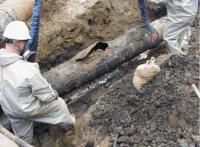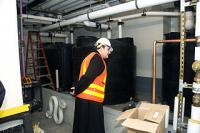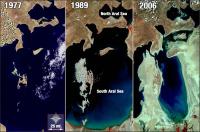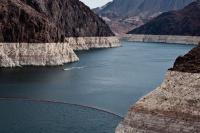-
FBI launches investigation of lead poisoning of Flint’s drinking water

The FBI has launched an investigation into the contamination of drinking water in Flint, Michigan, which has left Flint children and other residents poisoned by lead. In a hearings on the Hill yesterday, lawmakers from both parties described what is happening in Flint as a “a man-made public health catastrophe.” Flint’s drinking water became contaminated with lead in April 2014 after a state-appointed emergency manager ordered city officials temporarily to switch the city’s water source from Lake Huron water treated by the Detroit Water and Sewerage Department to water from the Flint River, treated at the Flint water treatment plant. The order by the state-appointed emergency manager was part of the state’s cost-cutting measures.
-
-
In kids, even low lead levels can cause lasting harm
Until a few years ago, the federal standard for action was 10 micrograms per deciliter of blood, and in 2012 it was lowered by half in recognition of evidence showing a lower threshold of concern. But the truth is there is no known safe level of blood lead for children, and the American Academy of Pediatrics and the Centers for Disease Control and Prevention have said as much. The medical research community has documented negative impacts on children with even lower levels of lead exposure than the current 5 micrograms per deciliters standard. With that view, we might consider every child with a confirmed nonzero lead test as at-risk. Testing lead blood levels in children is simply too late. This is akin to the TSA searching for lethal weapons after the passengers have boarded the flight and the plan has taken off. Once the lead is in the bloodstream, the damage is real and lasting for these children, and the options for response are far fewer and less effective. Children living in low-income neighborhoods, children of color, and children whose families live in rental housing are statistically at the greatest risk of exposure to lead. That means the children most at risk of lead exposure also disproportionately face the effects of poverty, low-resource communities, and trauma.
-
-
Flint Water Study research team to present findings on Thursday

Virginia Tech’s Marc Edwards and his team of research scientists and students will give a presentation on Thursday, 28 January, in Blacksburg to outline their work — done in collaboration with Flint, Michigan, residents — which exposed widespread lead-in-water contamination. The presentation will provide an overview of the Flint Water Study team’s efforts combining ethics engineering, citizen science, laboratory experiments, investigative science, and social media to confirm the high lead levels in Flint’s water.
-
-
Piping as poison: the Flint water crisis and America’s toxic infrastructure

As the crisis over the water in Flint, Michigan, rolls on, we’re learning more and more about the irresponsibility and callousness of officials and politicians in charge. The mix of austerity politics, environmental racism, and sheer ineptitude makes for a shocking brew, yet the physical conditions that have made it literally toxic for Flint residents are neither as exceptional nor as recent as much of the media coverage suggests. An estimated three to six million miles of lead pipes across the United States still carry water, and most all of them are vulnerable to similar dangers, whether at the hands of short-sighted and prejudicial bureaucrats or politicians whose ideology or opportunism leads them to blithely dismiss well-established science. The best solution would be to replace our lead lines systematically and proactively, not just one crisis-beset city at a time. Until we do so, it’s a safe bet that more Flints lie on our horizon.
-
-
Global water supply under increasing pressure
A new study projects that global demand for water could more than double by 2050, increasing pressure on already scarce water resources. “Our current water use habits increase the risk of being unable to maintain sustainable food production and economic development for the future generation,” says one researcher. Water efficiency and water saving measures could stabilize demand.
-
-
As climate warms, Colorado high peaks lose glaciers

Melting of ice on Niwot Ridge and the adjacent Green Lakes Valley in the high mountains west of Boulder, Colorado, is likely to progress as climate continues to warm, scientists have found. Their study reveals declines in ice — glaciers, permafrost, subsurface ice, lake ice — in the Niwot Ridge area over the past thirty years. For glaciers like Arikaree, the time left may be counted in years, not centuries nor millennia, says one expert.
-
-
Protecting drinking water
We place high demands on the quality of our drinking water. If pathogens or toxic substances found their way into the piping system, many people could become infected or injured very quickly. This is why this risk must be kept low. To do this, experts have developed technologies for a comprehensive monitoring, early warning and emergency management system.
-
-
Freshwater vulnerability threatens developing nations' stability
Many nations and regions already facing uncertain political futures must contend with a growing threat to stabilization: freshwater vulnerability. An analysis of 119 low-income countries finds common challenges that could inform broad solutions.
-
-
Stormwater, graywater offer alternative water sources

In the face of drought and major water shortages, the United States is increasingly turning to alternative water sources like stormwater and graywater, but guidelines and research on their risk to public health and the environment are needed to support decisions for safe use, says a new report. Graywater and stormwater could significantly supplement traditional potable water supplies using existing technology to capture and treat the waters, but there is currently limited information on the costs, benefits, risks, and regulation of such projects.
-
-
Climate change rapidly warming world’s lakes, threatening freshwater supplies

Climate change is rapidly warming lakes around the world, threatening freshwater supplies and ecosystems, according to a study spanning six continents. The study is the largest of its kind and the first to use a combination of satellite temperature data and long-term ground measurements. A total of 235 lakes, representing more than half of the world’s freshwater supply, were monitored for at least twenty-five years. The study found that lakes are warming an average of 0.61 degrees Fahrenheit (0.34 degrees Celsius) each decade. This is greater than the warming rate of either the ocean or the atmosphere, and it can have profound effects, the scientists say.
-
-
Scientists develop new way to find age of drinking water

It can take days for water to travel from a filtration plant to your tap and the length of time the journey takes could affect water quality. Disinfectants from water treatment, like chlorine, prevent the growth of harmful microbes, but they can break down over time, creating toxic byproducts in the process. Minimizing the water’s travel time in pipes reduces both processes, but measuring that time is difficult. Scientists have developed a new method of finding the age of water at any point in a distribution system using something that is already naturally in water: residual radioactive atoms from nuclear fallout of the 1950s and early 1960s.
-
-
Nature influences water in the Colorado River basin more than humans do

Researchers have found that the water supply of the Colorado River basin, one of the most important sources for water in the southwestern United States, is influenced more by wet-dry periods than by human use, which has been fairly stable during the past few decades. The team found that water storage decreased by 50 to 100 cubic kilometers (enough water to fill Lake Mead as much as three times) during droughts that occur about every decade. The big difference between recent and previous droughts is that there have been few wet years since 2000 to replenish the water. In contrast, multiple wet years followed drought years in the 1980s and 1990s.
-
-
Global freshwater loss due to dams, irrigation much larger than previously thought

Dams and irrigation, by increasing evapotranspiration, raise the global human consumption of freshwater to a much higher level than previously thought. This effect increases the loss of freshwater to the atmosphere and thereby reduces the water available for humans, societies and ecosystems on land.
-
-
U.S. worsening droughts require alternative ways of protecting urban water supplies

In the American West, unprecedented droughts have caused extreme water shortages. The current drought in California and across the West is entering its fourth year, with precipitation and water storage reaching record low levels. Droughts are ranked second in the United States in terms of national weather-related economic impacts, with annual losses just shy of $9 billion. With water scarcity likely to increase due to advancing climate change, the economic and environmental impacts of drought are also likely to get worse. Alternative models of watershed protection that balance recreational use and land conservation must no longer be ignored to preserve water supplies against the effects of climate change, experts argue.
-
-
Small landscape changes can yield big freshwater gains
A typical bird’s-eye view of the Midwest offers a patchwork landscape covered mostly by agriculture but mottled with forest, wetland, grassland, buildings, and pavement. This pattern influences the quality and supply of the many natural benefits the landscape provides people, including freshwater. A new opportunity for improving the health and supply of Wisconsin’s lakes, waterways, and groundwater has emerged from a recent study showing that making small tweaks to how large some of those patches in the pattern are could mean big freshwater benefits, especially where making drastic changes to the landscape would be hard, as is the case throughout much of the state.
-
- All
- Regional
- Water
- Biometrics
- Borders/Immig
- Business
- Cybersecurity
- Detection
- Disasters
- Government
- Infrastructure
- International
- Public health
- Public Safety
- Communication interoperabillity
- Emergency services
- Emergency medical services
- Fire
- First response
- IEDs
- Law Enforcement
- Law Enforcement Technology
- Military technology
- Nonlethal weapons
- Nuclear weapons
- Personal protection equipment
- Police
- Notification /alert systems
- Situational awareness
- Weapons systems
- Sci-Tech
- Sector Reports
- Surveillance
- Transportation
Advertising & Marketing: advertise@newswirepubs.com
Editorial: editor@newswirepubs.com
General: info@newswirepubs.com
2010-2011 © News Wire Publications, LLC News Wire Publications, LLC
220 Old Country Road | Suite 200 | Mineola | New York | 11501
Permissions and Policies
Editorial: editor@newswirepubs.com
General: info@newswirepubs.com
2010-2011 © News Wire Publications, LLC News Wire Publications, LLC
220 Old Country Road | Suite 200 | Mineola | New York | 11501
Permissions and Policies
